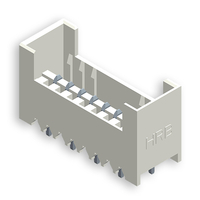It is quite easy to figure that we will briefly introduce you the RAST connector as long as you look at the title of this article. The aim is to make you have a rough impression of RAST connector, hoping this short essay could offer some extent help. In the article, we will recommend from four different parts:
1. The origin of RAST
2. The definition of RAST connector
3. The standard of RAST connector
4. The advantages of RAST connector
The origin of RAST
Back in the 1980s, European appliance manufacturers found themselves facing a host of problems stemming from the growing complexity of their products. In contrast to most North Americans, European customers have long been willing to pay a premium for appliances that use less water and electricity. Unfortunately, the sensors, electronic controllers and electrical actuators involved in meeting these demands, resulted in growing quality issues in the form of crossed and mismatched wires.
To solve this problem, appliance OEMs, wire harness makers and wire connector manufacturers, decided to create a block-terminal standard, along the lines of what automotive manufacturers had been using for some time. The result was a connector standard called Raster Anschluss Teck Technik, or RAST, which roughly translated means "pitch connection plug technology."
The definition of RAST connector
RAST connector is an abbreviation for Raster Anschluss Steck Technik. This word is usually followed by a number which indicates the contact centerline spacing of rast connector. For example, a RAST 5 interconnect includes a rast connector housing with contacts spaced on 5 mm center-lines.
RAST is the industry standard connector for the Home Appliance market. RAST is an kind of IDC (Insulation Displacement Connector), where the insulation of the cable is pierced by the terminal within the connector during assembly. This reduces process time; removing the need to cut, strip and crimp individual cables. High-speed automatic termination equipment is used to make high output, high quality RAST harnesses.
The standard of RAST connector
The RAST IDC connector system, including AMP multifitting connectors, AMP MONO-SHAPE connectors, and AMP DUOPLUG connectors, is specially designed for safe and fast automatic productions. The normal crimping solutions, including product lines from RAST 5 standard timer connectors, Positive Lock RAST 5 connectors to FASTIN-FASTON tab housing, are easily applicable in manual productions.
RAST 5 products are available in standard wire tab/receptacle and card edge mounted versions. Products are available with 6 to 16 ampere current ratings as common choices. The RAST 2.5 products offer space savings on Printed Wiring Board (PWB) vertical mount and card edge signal applications.
The RAST standard specifies a number of connection characteristics, including housing geometric dimensions, component/tab designation de-pending on component designation, and housing color-coding. Furthermore, the RAST standards outline polarization and keying features for the housing to prevent improper assembly. Also, internal or external latching mechanisms are available to increase the robustness of the interconnection.
The advantages of RAST connector
RAST technology provides a number of benefits to the OEM.
• It reduces the number of components in the harness by using a multiple-position connector.
•In many cases, the keying/polarization features can be customized on the automatic termination equipment, reducing the number of different parts that must be kept in inventory.
• The polarization and keying features reduce plugging errors.
• The latching system improves housing retention and system reliability.
• With an IDC connector and automated harness-making systems, labor costs are decreased compared to traditional crimp-snap products.
RAST connectors are used for a variety of appliance components, such as pressure sensors, relays, pumps and rotary switches. In addition, RAST products are specified for connections to printed circuit boards in motor controls and switches. Because the connectors have a standard configuration, OEMs and component suppliers can use standardized designs and have less need for custom-manufactured components.
For component manufacturers, harness makers and connector suppliers, domestic demand and opportunities in global markets will drive considerations to design products based on RAST standards. While the North American market has been somewhat slow to adopt the RAST system in the past, we expect the demand for RAST products to accelerate in the not-to-distant future as OEMs understand the benefits of a complete RAST system.
In short, from those four perspectives we provide an brief instruction about RAST connector: the origin, the definition, the standard and the advantages. Although the content of RAST connector may not sufficient enough, we want you could have a clearer mind about it and maybe handle your confusion to some extent.

 English
English















